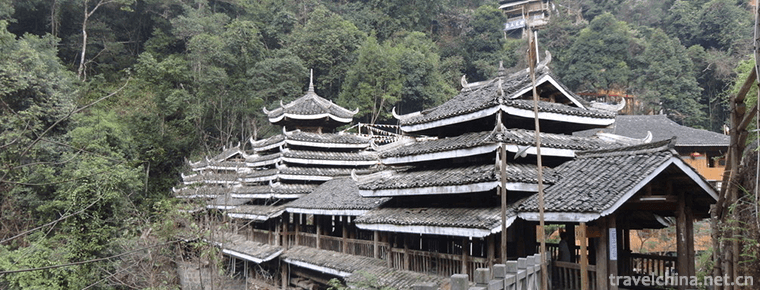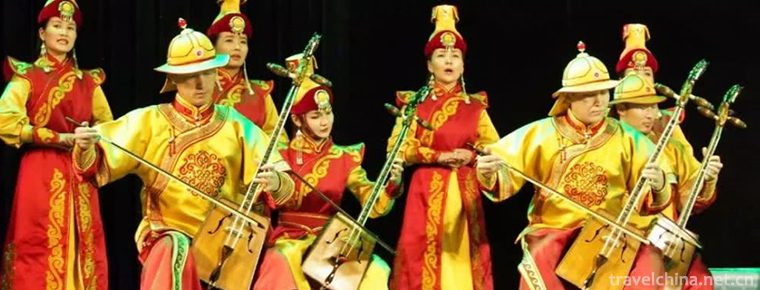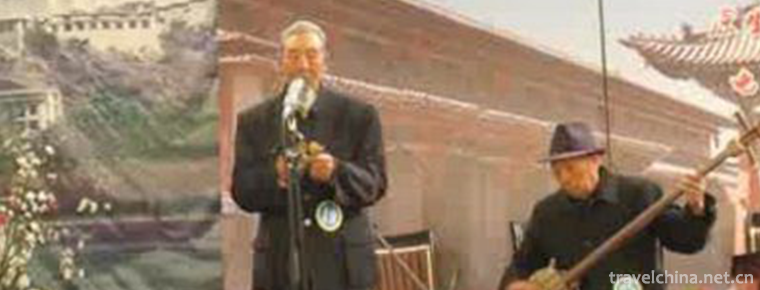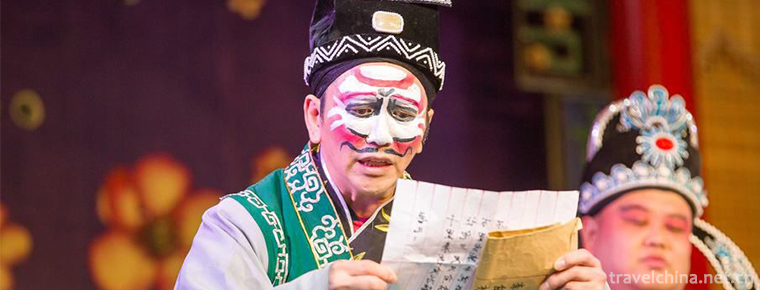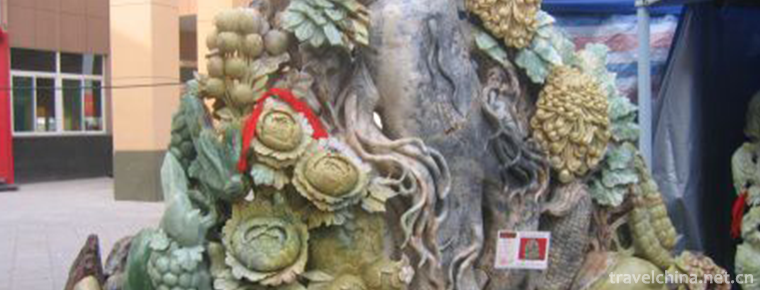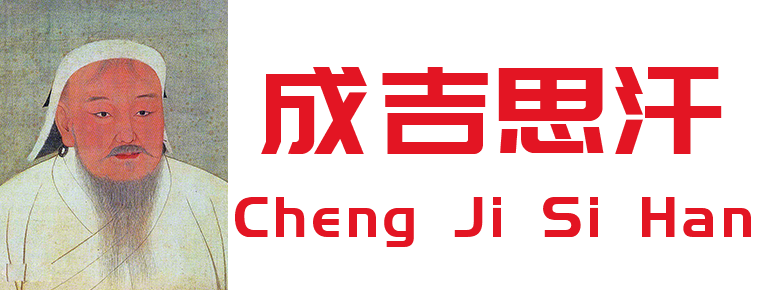Cuiyun corridor
Cuiyun corridor
Cuiyun corridor is a section of the ancient Shu Road, and also a section of Jianmen Shu Road, which is famous for its danger. Cuiyunlang, also known as "Huangbai" and "zhangfeibai" in ancient times, is located in Jiange County, Guangyuan City, Sichuan Province, and Zitong County, Mianyang City. Cuiyunlang in Jiange county has been built into a national AAAA scenic spot.
Basic introduction
In a broad sense, Cuiyun corridor can be divided into west section, north section and south section. It refers to the three roads with Jiange as the center, reaching Zitong in the west, Zhaohua in the north and Langzhong in the south. On both sides of these three winding 300 Li roads, there are tall and straight ancient Berlin, known as "three hundred thousand trees with a long distance".
According to statistics, there are 12351 ancient cypresses in Jianmen Shu Road, which are regularly distributed on both sides of the 344 Li post road, including 7886 in Jiange, 496 in Zitong, 144 in Zhaohua, 17 in Langzhong and 3808 in Nanjiang. It can be seen that the main body is still in Jiange.
Three hundred Li Cui Yun Gallery, the essence of the 7 kilometers north of Jianmen Pass, the great cypress Bay. The narrow sense of the green cloud corridor refers to the green cloud corridor scenic area here. Cuiyunlang scenic area is one of the first batch of national key scenic spots, one of the core scenic spots of Jianmen Shu Road, a national key cultural relics protection unit, and also a national forest park. The biggest and most famous trees in the 300 Li Cuiyun corridor are here.
The origin of the name
Cuiyunlang is named after the poems of Qiaobo, the magistrate of Jianzhou in the early Qing Dynasty.
In 1664, Qiao Bo, the magistrate of Jianzhou, wrote in a poem: "Jianmen Road, rugged and rugged stone road. Who are the two rows of cypresses planted. 300 miles, 100000 trees. Green cloud corridor, Cang smoke protection, moss flower shade, rain wet clothes, back to the Cote leaf cool demeanor. No stone can not sleep, everywhere can leave a sentence. It is said that it was Li Baifu in the past. Strange people and strange things make people jealous. Don't say Shu Road is difficult. Don't go wrong with sword path. " From then on, the poetic and picturesque name of "Cuiyun corridor" has become the elegant name of this section of Jinniu ancient road.
In fact, before that, the road had a grand name, called "Huangbai Avenue". That's because after Qin Shihuang unified China, he ordered Xianyang as the center to build a gallop road that could reach the whole country. On both sides of the road were rows of pines and cypresses to show the majesty of the emperor. Therefore, the trees planted in the Qin Dynasty were called "Huangbai", so this road was also known as "Huangbai Avenue".
History of tree planting
The formation of Cuiyun corridor has experienced more than 2000 years. With the development of the ancient Shu Road and the renovation of the post road, there are natural trees and a large number of artificially planted roadside trees along the road, gradually forming hundreds of miles of Avenue. In history, there were seven large-scale tree planting activities in Cuiyun corridor.
Qin Dynasty
After the unification of China, the first emperor of Qin ordered to build a gallop road with Xianyang as the center, planting rows of pines and cypresses on both sides of the road to show the emperor's prestige, "the road is 50 steps wide, and the trees are three Zhang Long". There is also a view that Qin Shihuang used to cut a lot of wood in Sichuan when he built the Afang palace. Du Mu described "the mountain of Shu is Wu, a Fang comes out" in his Fu of Afang palace. In order to calm the people's indignation, Qin Shihuang advocated planting trees beside the post road. People call the trees planted in the Qin Dynasty "Huangbai", so this road is also known as "Huangbai Avenue". According to the research of forestry experts, the ancient cypress with a DBH of more than 2 meters and a tree age of more than 2000 years along the Cuiyun corridor should have been planted in the Qin Dynasty, which is the earliest known tree planting record of this road.
Shu Han
Zhang Fei was the second to plant trees on a large scale in Cuiyun corridor. It is said that Zhang Fei was the prefect of Brazil (now Langzhong county), and had frequent military and political exchanges. At that time, Jianzhou (today's Jiange) was also an important place from the capital of Shu to the Central Plains. In order to meet the political and military needs, Zhang Fei ordered the soldiers and the people to plant trees along the post road. The army and the people worked together to complete the tree planting obligation. The story of Zhang Fei's "planting trees in the morning and enjoying the cool in the afternoon" is also popular among the people. According to research, the ancient cypress with DBH more than 1.8 meters on Cuiyun corridor should be "zhangfeibai".
Eastern Jin Dynasty
The third time was in the Eastern Jin Dynasty. Due to the rise of Taoism, people attach importance to the art of geomancy, and Jiange is also the birthplace of Taoism, so a large number of "fengmai" trees are planted. For this reason, Shangshu Lang Guo Pu wrote the story of planting pine, which was engraved on a stone tablet. In the Song Dynasty, due to wind and rain erosion, the local people asked Su Shi, a great scholar, to re write the inscription. Today, the inscription is still in Wulian Jueyuan temple. It is estimated that the cypress on the Cuiyun corridor with a DBH of about 1.78 m was planted at this time.
Northern Zhou Dynasty
The fourth time was in the Northern Zhou Dynasty, when people used to calculate the mileage, they used to build a pile of soil to mark every mile along the road, but this method was easy to be destroyed by wind and rain. Later, it was changed to plant one tree per mile and calculate the mileage by one tree per mile. However, there is no record of what kind of trees were used at that time.
Tang dynasty
The fifth time was Tang Dynasty. It is said that during the reign of emperor Tianbao of Tang Dynasty (742-756 A.D.), Yang Guifei liked to eat litchi from southern Sichuan. Emperor Xuanzong ordered people to rush their horses and carry them overnight. In order to keep the taste of litchi and make the common people plant cypress along the way, the people of Jiange planted and supplemented the original foundation, which made Cuiyun corridor take shape. The green cloud corridor at this time is also known as "love Avenue".
Northern Song Dynasty
The sixth time was in the Northern Song Dynasty. According to the records of "the draft of essentials of Song Hui · Fangyu · road", in 1025, Emperor Renzong of Song Dynasty issued an edict: "from Fengzhou (now Baoji, Shaanxi Fengxian, Shaanxi) to Lizhou (today's Guangyuan), Jianmen pass directly into Yizhou (Chengdu) road, along both sides of the official road, appropriate trees should be planted every year." This is another large-scale tree planting, and extended to the entire Shu Road.
the ming dynasty
The seventh was the Ming Dynasty. In the 13th year of Zhengde (1518), Li Bi, a native of Guangxi, became the magistrate of Jiange. He renovated the official roads from Langzhong in the south, Zitong in the West and Zhaohua in the north, and planted a large number of cypresses along the roads. Therefore, according to the preface of the poem "Cuiyun corridor" by Qiao Bo of Qing Dynasty in Tongzhi's Jianzhou annals, "Li Bi, the magistrate of the state in the Zhengde period of the Ming Dynasty, built roads with stones and planted hundreds of thousands of cypresses on both sides. They are embracing each other in the past and now, like a dragon winding, and there is no sun in summer." From then on, Cuiyun corridor formed a grand scale.
In fact, the seven tree planting activities mentioned above are only large-scale and far-reaching activities in history. Almost every dynasty in Jianmen Shu Road planted trees, but there is no record.
Reasons for planting cypress
Why did the ancients plant so many ancient cypresses. The first is to plant trees as road signs; the second is to calculate the distance by trees, which has a milestone effect; the third is to protect the road from rain washing the subgrade; the fourth is to facilitate the construction of trestle Road, and to cut wood nearby; the fifth is to provide convenience for pedestrians, shading and summer.
Historical protection
The preservation of the ancient cypress in cuiyunlang is closely related to the strict protection of the past dynasties. Since there are post roads and street trees, people have taken protecting roads and loving trees as their own responsibilities. People in mountainous areas regard building bridges and roads, planting mulberry trees and cypresses as a kind of virtue, and they also have good habits of loving roads and trees.
The rulers of the past dynasties also attached great importance to the protection of post roads and trees. From the Qin and Han Dynasties to the Tang Dynasty, special personnel were assigned to manage the trees. In the Northern Song Dynasty, regulations on the management of street trees were promulgated. According to the history of the Song Dynasty, an edict was issued to forbid cutting border trees in Sichuan. In the Ming Dynasty, there was a government order that "the government and the people forbid cutting". It is recorded in history that during the Zhengde period, Jianzhou officials had to count the street trees each other when they took over their duties, and regarded planting trees to protect roads as a political achievement and one of the important criteria for promotion. In the Qing Dynasty, the government also sent officials to inspect and protect trees along the road.
In 1935, due to the construction of the Sichuan Shaanxi highway, the ancient cypresses were seriously damaged, and the people were very angry. Later, after Chiang Kai Shek knew about it, he also ordered to hang wooden plates on the ancient cypresses and issued a ban that "those who cut down the imperial cypresses will be shot dead.". After the founding of the people's Republic of China, the government attached great importance to the protection of the ancient cypress in cuiyunlang. It took decisive measures to prohibit anyone from cutting down. It promulgated regulations on the management of ancient cypress. It also carried out three times of clearing and registration, listing and numbering. It strengthened and maintained the withered and dangerous ancient cypress. Every year, it carried out mass disease prevention, pest control and replanting of young cypress.
It is the protection of officials and people in the past dynasties that the landscape of "three hundred miles and one hundred thousand trees" has been formed. It is also the implementation of protection measures in the past dynasties that has made the ancient cypress of cuiyunlang live longer, more vigorous and green.
Scenic spots
Cuiyunlang scenic area is not only one of the first batch of national key scenic spots and one of the core scenic spots of Jianmen Shudao, a national key cultural relic protection unit, but also a National Forest Park and a national 4A tourist attraction.
Entering the scenic area, close to the 108 National Highway, there are thousands of ancient cypresses in various shapes and styles, with green green and green clouds. People choose many beautiful names according to their growth, appearance and historical legends. For example, "Yuanyang tree", "sister tree", "Luohan tree", "Guanyin tree" and "Baixiang swallow stone" are named after their growth; No.1 cypress, Shuai Da Bai, and Shouxing tree are named after their strength; and "adobai", "Wangxiang cypress", "Shiniu tree" and "fairy tree" named after historical classics are really "shame and similarity in all aspects".
Ancient cypress King
Not far to the north of Qiqu mountain temple, a giant cypress, 24 meters high and 6.7 meters thick, with a crown covering 45 square meters and more than 2300 years old, is vigorous, vigorous and lush. This ancient cypress is known as the "king of ancient cypress" on the Cuiyun corridor.
Mandarin duck cypress
Yuanyang cypress is 18 meters high, 1 meter DBH and 11 cubic meters in volume. Two thick branches are separated from the same tree head to form a pair of mandarin ducks sleeping with each other's necks, so it is named Yuanyang cypress. It is said that this cypress is a pair of mandarin ducks reincarnated in Jianmen mountain area. Lovers come here to pray for more love.
Tianqiaobai
Tianqiao cypress is 18 meters high, 1 meter DBH and 10 cubic meters in volume. It is named because of its huge branches stretching across the sky like a bridge in the air. It is said that it was the passage for the gods to go to heaven in ancient times.
Evergreen pine and cypress
Pine and cypress evergreen tree, 27 meters high, DBH 1.16 meters, volume 10.9 cubic meters. According to expert research, the tree was planted about 2300 years old in the reign of King Huiwang of Qin Dynasty. Its trunk is like pine, branches and leaves like cypress, fruit is bigger than cypress fruit, smaller than pine fruit, both like pine and cypress. On March 21, 1963, when inspecting Cuiyun corridor, chairman Zhu De instructed that "we should protect this evergreen pine and cypress tree well" and "pine and cypress evergreen" came from this. It is said that Deng Xiaoping, Yang Shangkun, Guo Moruo, etc. have also visited here successively. In 1987, it was identified as an endangered ancient tree species by the plant classification experts of the Institute of forestry. It is the only one in the world. It is named "jianggebai" and announced as a first-class protected tree species.
Adobo
In the summer of 263 in the Shu Han period of the Three Kingdoms, Liu Chan, the empress of Shu, descended to Wei Dynasty and was escorted to Luoyang. When he passed by, the rain fell heavily and he took shelter under the tree. After arriving in Luoyang, it was reported that ah Dou didn't think about the shame of his country's subjugation and that he was happy not to miss Shu. After hearing this, the common people were very angry and resentful of the tree, so they burned the knife and cut it. For a long time, half of the tree trunks on the south side were all dried up. People use this tree to describe people who do not want to make progress and are difficult to become talents. They are called "adobai" or "crooked neck tree".
Husband and wife cypress
It is 27 meters in height, 1.2 meters in diameter at breast height and 17 cubic meters in volume. This tree is covered with branches and crisscrossed with twigs. It looks like a couple of lovers whispering and exchanging feelings. People call it "husband and wife cypress". It is said that the local newly married and married couples often come here to pray, hoping that the couple's feelings will last forever like this cypress.
Bai dashai
Handsome Big Bo. On March 21, 1963, chairman Zhu De inspected Cuiyun corridor. In front of the evergreen pine and cypress trees, a member of the entourage sighed, "this tree is really big." "There is a big and handsome tree ahead," a farmer said in a local dialect "What is a handsome tree?" the staff asked Chairman Zhu De said humorously, "a big tree is a big tree, like a marshal's tree." Accompanied by the local party and government leaders, chairman Zhu De visited the giant cypress tree, which covered the sun and shaded the sky. The name of the tree was thus named. Shuai Dabai is 29 meters high, 2.24 meters DBH, 33.9 cubic meters in volume, and more than 2500 years old. It is one of the largest cypress trees in cypress Bay of cuiyunlang.
Zhang Feijing
In the cypress forest, there is a well called zhangfei well. It is said that Zhang Fei, a general of the Shu Han Dynasty, was ordered to make a northern expedition. At this point, the soldiers were hungry and thirsty, and the horses were foaming at their mouths. Zhang Fei ordered the soldiers to look for water everywhere, but there was no water source. He was upset. He raised his fist and gave a fierce drink: "I'm thirsty." The fist hit the ground, and a spring came out of the seal, relieving hunger and thirst. Zhang Fei also ordered soldiers to make a deep well from the round pit made by their fists for local villagers to drink. In order to thank Zhang Fei, the people called this well "zhangfei well".
Stone tablet of Cuiyun corridor
At the South Gate of Cuiyun corridor, there are two stone tablets, namely "Cuiyun corridor" inscribed by general Zhang Aiping, former Minister of national defense and Confucian general in 1983, and "Cuiyun corridor" inscribed by Chinese famous calligrapher Mr. Sha Menghai in 1984.
Stone statue of Zhang Fei
Along the path to the mountain ridge, the first thing you can see is a stone statue with a stele beside it. It is recorded that Zhang Shao, the second son of Zhang Fei, was engraved by later generations for his meritorious service of planting trees to protect the road.
Some people say that this stone statue is Zhang Fei. In the Shu Han Dynasty, Zhang Fei served as the prefect of Brazil (Langzhong), where he was in charge of military affairs and government affairs. He often left Sichuan with his plumes, which was often delayed by the precipitous Jianmen mountain and his ignorance of the route. Zhang Fei ordered the soldiers to cut stones and open mountains from Langzhong to Zhaohua, expand the Yangchang trail into a stone road with a width of more than 10 meters, plant cypresses on both sides, and strictly protect them. Baidao is not only conducive to the March, but also convenient for merchants and local people to walk. Later, the common people, in order to thank him for planting cypress and protecting cypress, made a stone statue here to commemorate it.
Li Bi Temple
On the ridge of Cuiyun corridor, there is the ancestral hall of Li Bi, an official and scholar of Ming Dynasty. There are Li Bi's statues in the temple. Li Bi (~ 1525) was named Bai Fu and Zhuo Zhai. Wu Yuan (now Wuming County, Guangxi Zhuang Autonomous Region) is a Zhuang nationality. In 1495, he served as an imperial edict in Lanxi County and Renhe County, Zhejiang Province, and gave lectures in Nanjing with Zhang Mao. In the 10th year of Zhengde's reign (1515), he became the magistrate of Jianzhou (today's Jiange) in Sichuan Province. He built a sword Pavilion Road, advocated the construction of schools and academies, and increased the trade market. In 1521, he was promoted to be a member of Lin'an Prefecture in Yunnan Province. In 1525, he was transferred to Nanking Hubu yuanwailang, who died of illness. He is the author of new records of Jianmen, famous Confucian records, Huangming music score, jiangge collection and other books.
When Li Bi became the magistrate of Jianzhou, the war was just over, the city walls of Jianzhou were dilapidated, and the people's lives were in ruins. In particular, he advocated the renovation of the 300 Li official road from sword to Baoning prefecture (Langzhong), organized migrant workers to plant cypress trees on both sides of the road, and issued a ban on cutting by officials and people. In the 46th year of the Wanli reign of the Ming Dynasty (1618), Zhu Cai, a native of the state, wrote a record of rebuilding the Confucian temple According to the poem "Cuiyun corridor" written by Qiao Bo in Jianzhou Zhi of Yongzheng of Qing Dynasty: "who are the two lines of ancient cypresses planted It is said that it was Li Baifu in the past. " Tongzhi "Jianzhou Zhi" records: "ten thousand ancient cypress trees, planted by Bi." Li Bi's actions of planting, mending and protecting cypresses played an extremely important role in the formation of Cuiyun corridor. In order to cherish the memory of Li Bi and Yang Ruzhen, who served as prefects of Jianzhou, Jianzhou people built Erxian temple in the ancient city Pu'an (Pu'an Town, Jiange county) in the eighth year of Wanli of the Ming Dynasty (1580). In 1883, the temple was rebuilt in xiaolinglong (a community in Pu'an town). Later, the local government built a new temple to worship Li Bi to praise his achievements in planting and protecting cypresses.
Cuiyun building
There are Cuiyun buildings on the top of the mountain. Cuiyun tower is a pavilion with folk characteristics built on the ancient beacon tower site. During the period of Qin, Han and Three Kingdoms, it played an important role in military affairs. In order to protect the fenghuotai site, this building was built in JIANMENGUAN National Forest Park in 1992 for tourists to climb. It is also a lookout tower for observing fire danger in Jianmen forest farm.
Climbing Cuiyun tower, you can have a view of the magnificent scenery of Jianmen 72 peak and Cuiyun corridor. If you look around, the ancient cypress forest is luxuriant, majestic and lush. It is like a ribbon of jadeite, winding around the mountains and mountains; it is also like a wild dragon, which sets off the ancient and majestic scenery of Sichuan Road.
Social evaluation
Cuiyun corridor is an unparalleled ancient street tree, a pearl on the Shu Road, a work of art watered by the labor people of all ages, and a symbol of the great creativity of the Chinese nation. She is not only a large-scale, long-standing, well protected Chinese art treasures, but also a treasure of the world. "The roots of the snake are startled, and the weak stem knows the Phoenix." "the old cypress is towering in the sky, and the people are walking in the green tent", "the green clouds are falling down on the road, and the cypress is especially in love with the towering sky.". The vigorous body retains the simple charm; the feelings of jadeite green people's mind. Wandering in the green cloud corridor, walking along the ancient stone road of Sichuan, I miss the moon of Qin Guan and Han Dynasty, chant the style of Tang Dynasty and Song Dynasty, cherish the boundless history and feel the long time.
Cuiyun corridor is rich in tourism resources, natural resources and biological resources. Scientists call the ancient cypress a "forest fossil", while cultural relic experts regard it as "the soul of Shu Road" and "the treasure of the country". Scholars call it the "Green Great Wall". Foreign experts praised it as "a unique spectacle", "a living fossil of ancient land transportation", "more beautiful than the European road of Rome", and "world cultural heritage".
Indeed, it is not too much to praise the "Cuiyun corridor". It not only brings people pleasant visual enjoyment, fresh air and beautiful environment, but also gives meticulous care to the ancient Shu Road, so that the ancient Shu Road has a good driving environment and smooth road surface.
Cuiyun corridor the Pearl of Shu Road!
Shopping guide
Jianmen tribute tea
Jianmen walking stick: exquisite workmanship and exquisite material selection
Guangyuan White Flower Stone Carvings: one of the best stone carvings in China
Shopping in Guangyuan, Sichuan, China
Tourist guide
aircraft
Guangyuan Panlong airport is located in Panlong town in the southwest of Guangyuan City, only 14 kilometers away from Guangyuan City.
Railway
Baoji Chengdu line passes through Guangyuan district from north to south. Guangyuan railway station is on the West Bank of Jialing in the northwest of Guangyuan City. You can take any train running along Baocheng line to Guangyuan City. After leaving the station, you can take bus No.
highway
National Highway 108 (Sichuan Shaanxi highway) and 212 (Sichuan Gansu highway) cross each other in Guangyuan District, forming an "H" type structure. These two national highways also constitute the main frame of highway traffic in Guangyuan. People can go up and down along these two national highways. There are four bus stations in Guangyuan City. You need to choose the bus stop according to your destination.
Guangyuan bus station is located at No. 54, Shumen South Road, Shizhong District,
Route: Chengdu, Deyang, Mianyang, Jiangyou, Suining, Santai, Yanting, Wangcang, Cangxi, Yuanba, Sandui, Zhaohua, main towns in Shizhong District and some townships in Yuanba district.
Shangxi coach station
Address: next to shangxiba Railway Station Square
Route: Tongjiang, Nanjiang, Bazhong, Zhengzheng, Nanchong, Chongqing, Nanbu, Langzhong, Cangxi, Hanzhong, Houma and Cangxi counties.
Jialing long distance bus station
Food Guide
The fragrant and pure Jianmen ham was named as "imperial tofu" by Liu Bei. Sichuan Guangyuan Specialty: Jianmen tofu; introduction to Guangyuan restaurants; Sichuan Guangyuan snacks: steamed cold noodles.

-
Kashgar Ancient City
The ancient city of Kashgar, a national AAAAA tourist attraction, covers an area of 20 square kilometers. The capital of Shule was renamed Panzhi City, the predecessor of Shule City in the Western Han.
Views: 118 Time 2018-12-12 -
Beijing Ocean Hall
Beijing Ocean Hall, located on the North Bank of Changhe River in Beijing Zoo, is adjacent to Beijing Exhibition Hall, Astronomical Museum and Capital Stadium in the south. It covers an area of 120,00.
Views: 112 Time 2018-12-26 -
Du Shoutians former residence
Du Shitian's former residence is the old residence of Du Shitian, the emperor's teacher of the Qing Dynasty, as well as the old residence of many famous officials of the Du family. Located in Binzhou .
Views: 145 Time 2019-01-08 -
Longsheng Hot Spring Resort
Longsheng Hot Spring is located 32 kilometers northeast of Longsheng County. It takes 40 minutes to get to Longsheng Hot Spring by bus from the county town. Hot springs are gushed from rock strata 120.
Views: 184 Time 2019-02-06 -
Asil Lysi
"Asr" is the abbreviation of "Asru Winder" in Mongolian, and its translation is of great significance. Asr is a kind of Mongolian court music, which has a unique national style and.
Views: 218 Time 2019-03-28 -
Traditional Sugar making Techniques
In the memory of many Wenzhou people, when they were young, they were short of doctors and medicines, but the old people had many earthen prescriptions which were very useful..
Views: 98 Time 2019-04-21 -
Qinghai Lower String
Qinghai Xixian, which originated in the late Qing Dynasty, is one of the traditional folk arts native to Qinghai. It is a sitting and singing art, singing alone or in pairs..
Views: 245 Time 2019-06-11 -
Taining Meilin Opera
During the reign of Qianjia in Qing Dynasty, after Hui Diao was introduced into Taining through Zhejiang and Jiangxi, it merged with local dialect, folk song minor and Taoist music to form Taining Mei.
Views: 155 Time 2019-06-18 -
Xiuyan Jade Carving
Xiuyan Jade Carving, one of the national intangible cultural heritage, is a local traditional art in Xiuyan Manchu Autonomous County, Liaoning Province..
Views: 116 Time 2019-07-08 -
Genghis Khan Cheng Ji Si Han
He was a Jin Jin. He was from May 31, 1162 to August 25, 1227. Yeke Mongghol Ulus Khan, outstanding in world history. Politician , Militarist.
Views: 147 Time 2019-09-07 -
Beijing University of Chinese Medicine
Beijing University of Traditional Chinese Medicine is a national key university with traditional Chinese medicine as its main subject. It is directly under the management of the Ministry of Education..
Views: 132 Time 2019-09-22 -
Luzhou cuisine
Sichuan hotpot, famous for its hemp, spicy, fresh and fragrant, is the representative of Sichuan cuisine. It is said that the birthplace of Sichuan hotpot is xiaomitan in Luzhou (near Gaoba, Luohan street, Longmatan District)..
Views: 69 Time 2020-12-14



